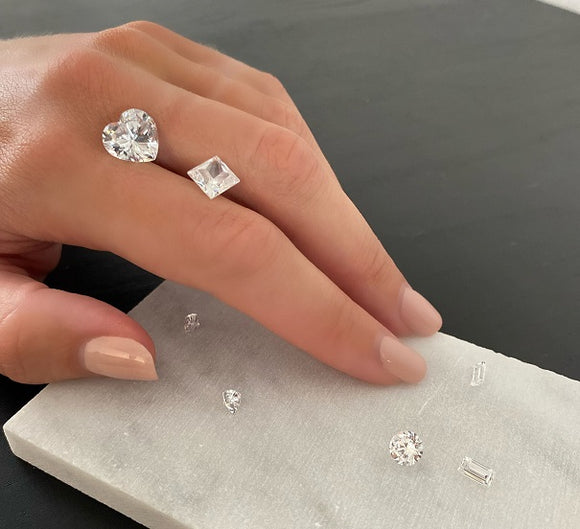When selecting a lab grown diamond ring, one of the crucial aspects to consider is the design of the setting, specifically the claws that hold the diamond in place. The design and functionality of these claws are essential for both the aesthetics and security of the ring. This article provides an in-depth look at the role of claws in lab grown diamond rings, helping you make an informed choice for your next jewelry purchase.
What Are Claws in Lab Grown Diamond Rings?
In the context of lab grown diamond rings claws, claws are small metal prongs or settings designed to hold the diamond securely in place. These claws extend from the band of the ring and wrap around the edges of the diamond to keep it mounted firmly. Claws are a fundamental component of ring settings, ensuring that the diamond is both visible and protected.
The Function of Claws in Securing Lab Grown Diamonds
The primary function of claws in lab grown diamond rings is to secure the diamond and prevent it from shifting or falling out. Properly designed and crafted claws ensure that the diamond is held firmly while allowing maximum light to enter and reflect off the gem. This results in enhanced brilliance and sparkle, making the diamond appear more radiant. Claws also provide a layer of protection against accidental knocks or bumps that might damage the stone.
Different Types of Claws for Lab Grown Diamond Rings
There are several types of claws commonly used in lab grown diamond rings, each offering different aesthetic and practical benefits. Some of the most popular types include:
- Prong Claws: These are the most traditional type of claws, consisting of four or six metal prongs that grip the diamond. Prong claws are versatile and work well with various diamond shapes and settings.
- Bezel Claws: In a bezel setting, the diamond is surrounded by a metal band that secures it in place. This type of claw provides maximum protection for the diamond and creates a sleek, modern look.
- V-Prong Claws: V-prong claws are designed with a V-shaped prong that extends around the corners of the diamond. This design enhances the diamond’s visual appeal while providing additional security.
The Importance of Claw Design in Lab Grown Diamond Rings
The design of claws in lab grown diamond rings is crucial for both aesthetic and functional reasons. Well-designed claws ensure that the diamond is securely held while allowing it to shine brightly. The choice of claw design can also impact the overall style of the ring, from classic and elegant to contemporary and bold. Proper claw design balances the need for security with the desire for visual appeal, making it a key consideration in ring selection.
Choosing the Right Claws for Your Lab Grown Diamond Ring
When selecting claws for a lab grown diamond ring, consider the following factors:
- Diamond Shape: The shape of the diamond can influence the type of claws that work best. For example, round diamonds often look great with traditional prong claws, while fancy shapes like emerald or pear may benefit from bezel or V-prong settings.
- Style Preferences: Your personal style preferences will guide your choice of claw design. Whether you prefer a classic look with prong claws or a modern feel with bezel settings, ensure that the claws complement the overall design of the ring.
- Durability and Security: Opt for claws that offer both durability and security. High-quality metal and craftsmanship will ensure that the claws hold the diamond securely and withstand everyday wear.
Maintenance and Care for Claws in Lab Grown Diamond Rings
To keep the claws in lab grown diamond rings in good condition, regular maintenance is essential. Periodic inspections by a professional jeweler can help identify any signs of wear or looseness. Cleaning the ring regularly to remove dirt and oils will also help maintain the appearance and functionality of the claws. Proper care ensures that the claws continue to securely hold the diamond and enhance its brilliance.
Common Issues with Claws in Lab Grown Diamond Rings
Some common issues with claws in lab grown diamonds rings include:
- Loosening: Over time, claws may become loose, affecting the security of the diamond. Regular checks and adjustments by a jeweler can prevent this issue.
- Wear and Tear: Daily wear can cause claws to become scratched or bent. Proper care and occasional maintenance can mitigate these problems.
- Dirt and Debris: Accumulated dirt and debris can obscure the diamond’s brilliance. Regular cleaning helps maintain the diamond’s sparkle and overall appearance.
Final Thoughts on Claws in Lab Grown Diamond Rings
In conclusion, claws are a vital component of lab grown diamond rings, playing a key role in securing and showcasing the diamond. Understanding the different types of claws and their functions can help you make an informed decision when choosing a ring. By considering the diamond shape, style preferences, and maintenance needs, you can select a lab grown diamond ring with claws that offer both beauty and security.

